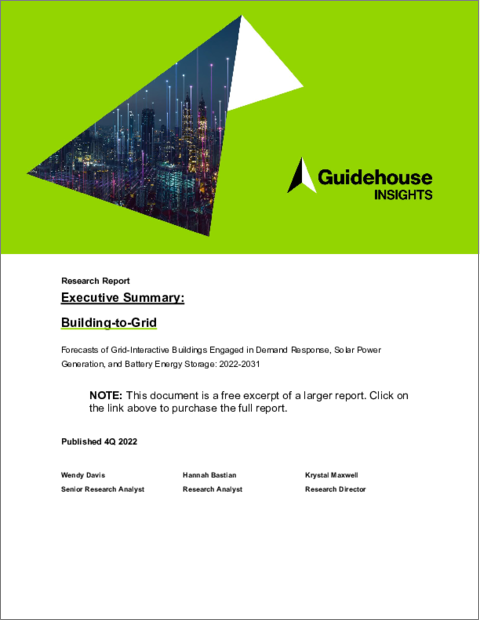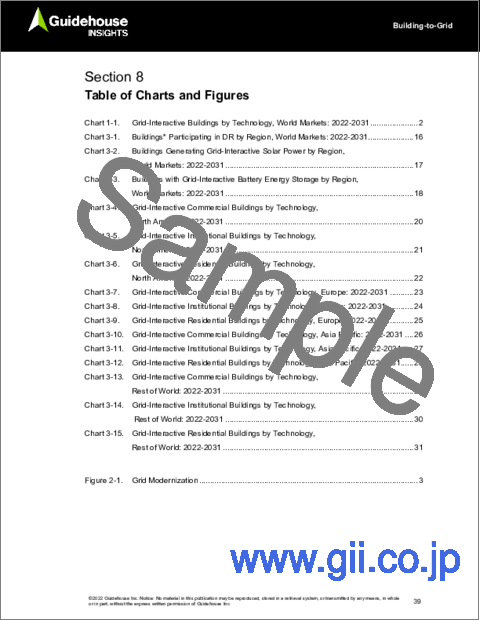|
|
市場調査レポート
商品コード
1174005
B2G(Building-to-Grid):デマンドレスポンス、太陽光発電、バッテリーエネルギー貯蔵を活用したグリッドインタラクティブビルディングの予測(2022年~2031年)Building-to-Grid: Forecasts of Grid-Interactive Buildings Engaged in Demand Response, Solar Power Generation, and Battery Energy Storage, 2022-2031 |
||||||
| B2G(Building-to-Grid):デマンドレスポンス、太陽光発電、バッテリーエネルギー貯蔵を活用したグリッドインタラクティブビルディングの予測(2022年~2031年) |
|
出版日: 2022年12月13日
発行: Guidehouse Insights
ページ情報: 英文 44 Pages; 37 Tables, Charts & Figures
納期: 即納可能
|
- 全表示
- 概要
- 図表
- 目次
B2G(Building-to-Grid)の普及を後押ししているのは、送電網の近代化と脱炭素化、エネルギー生産消費者の増加、技術の進歩によるハードウェアとソフトウェアの入手容易化、支援的な政策と規制といった市場環境です。しかし、この市場は、技術の成熟度や導入のばらつき、消費者の認識や受容度の低さ、既存のエネルギービジネスモデルや政策、機器の相互運用性やサイバーセキュリティに関する懸念など、いくつかの課題に直面しています。
当レポートでは、需要の柔軟性、太陽光発電、バッテリーエネルギー貯蔵への参加を通じて、グリッドインタラクティブビルディングのストックを分析し、市場の促進要因と障壁、市場予測などの情報を提供しています。
目次
第1章 エグゼクティブサマリー
- 概要
- 市場促進要因
- 市場の障壁
- 市場の展望
第2章 市場の問題
- イントロダクション
- デマンドレスポンス
- 分散型発電
- 分散型エネルギー貯蔵
- 市場促進要因
- 送電網の近代化と脱炭素化
- 生産消費者の時代
- 実現技術の普及
- トランザクティブエナジーの出現
- 政策と規制
- 市場の障壁
- 技術の成熟度と導入
- 顧客の認識と受容度
- 既存のエネルギービジネスモデルと政策
- 相互運用性とサイバーセキュリティ
第3章 市場予測
- 調査手法
- デマンドレスポンス予測
- 太陽光発電予測
- バッテリーエネルギー貯蔵予測
- 地域市場予測
- 北米
- 欧州
- アジア太平洋
- その他の地域
第4章 結論・提言
- ユーティリティ
- 機器メーカー
- 建築設計者と所有者
- 政府・規制当局
第5章 ビルディングタイプ
- オフィス
- 小売
- 教育
- ヘルスケア
- ホテル・レストラン
- 施設/議会
- 倉庫
- 輸送
第6章 頭字語と略語のリスト
第7章 目次
第8章 図表
第9章 調査範囲、情報源、調査手法、注記
List of Tables
- Grid-Interactive Buildings by Technology, World Markets: 2022-2031
- Buildings* Participating in DR by Region, World Markets: 2022-2031
- Buildings Generating Grid-Interactive Solar Power by Region, World Markets: 2022-2031
- Buildings with Grid-Interactive Battery Energy Storage by Region, World Markets: 2022-2031
- Grid-Interactive Commercial Buildings by Technology, North America: 2022-2031
- Grid-Interactive Institutional Buildings by Technology, North America: 2022-2031
- Grid-Interactive Residential Buildings by Technology, North America: 2022-2031
- Grid-Interactive Commercial Buildings by Technology, Europe: 2022-2031
- Grid-Interactive Institutional Buildings by Technology, Europe: 2022-2031
- Grid-Interactive Residential Buildings by Technology, Europe: 2022-2031
- Grid-Interactive Commercial Buildings by Technology, Asia Pacific: 2022-2031
- Grid-Interactive Institutional Buildings by Technology, Asia Pacific: 2022-2031
- Grid-Interactive Residential Buildings by Technology, Asia Pacific: 2022-2031
- Grid-Interactive Commercial Buildings by Technology, Rest of World: 2022-2031
- Grid-Interactive Institutional Buildings by Technology, Rest of World: 2022-2031
- Grid-Interactive Residential Buildings by Technology, Rest of World: 2022-2031
Grid-Sited Building-to-Grid Technologies
Building-Sited Building-to-Grid Technologies
Building-to-Grid Policy Examples
Sources of Total Curtailment/Capacity Estimates Used to Generate Building-to-Grid Forecasts
List of Figures
- Grid-Interactive Buildings by Technology, World Markets: 2022-2031
- Buildings* Participating in DR by Region, World Markets: 2022-2031
- Buildings Generating Grid-Interactive Solar Power by Region, World Markets: 2022-2031
- Buildings with Grid-Interactive Battery Energy Storage by Region, World Markets: 2022-2031
- Grid-Interactive Commercial Buildings by Technology, North America: 2022-2031
- Grid-Interactive Institutional Buildings by Technology, North America: 2022-2031
- Grid-Interactive Residential Buildings by Technology, North America: 2022-2031
- Grid-Interactive Commercial Buildings by Technology, Europe: 2022-2031
- Grid-Interactive Institutional Buildings by Technology, Europe: 2022-2031
- Grid-Interactive Residential Buildings by Technology, Europe: 2022-2031
- Grid-Interactive Commercial Buildings by Technology, Asia Pacific: 2022-2031
- Grid-Interactive Institutional Buildings by Technology, Asia Pacific: 2022-2031
- Grid-Interactive Residential Buildings by Technology, Asia Pacific: 2022-2031
- Grid-Interactive Commercial Buildings by Technology, Rest of World: 2022-2031
- Grid-Interactive Institutional Buildings by Technology, Rest of World: 2022-2031
- Grid-Interactive Residential Buildings by Technology, Rest of World: 2022-2031
Grid Modernization
Digitalization and technological advances have transformed the ways that buildings interact with the electric grid. In the past, buildings simply consumed energy and grid operators adjusted supply to meet energy demand. Today, the proliferation of distributed energy resources (DER), such as onsite solar PV, battery storage, and grid-connected appliances (e.g., thermostats and water heaters), allow buildings to have two way interactions with the grid. With these technologies, building owners have greater control and flexibility over their energy generation and consumption and are incentivized to provide benefits to the grid, like shedding or shifting loads during periods of supply constraint.
Several market conditions are driving increased building-to-grid (B2G) integration, including grid modernization and decarbonization goals, the rise of the energy prosumer, technological advances that have made enabling hardware and software readily available, and supportive policies and regulations. Nonetheless, this market faces several challenges, including uneven technology maturity and adoption, relatively low consumer awareness and acceptance, incumbent energy business models and policies, and concerns about equipment interoperability and cybersecurity.
This Guidehouse Insights report analyzes the global building stock interacting with the electrical grid through participation in demand flexibility, solar power generation, and battery energy storage. Market drivers and barriers are discussed in relation to the motivations of diverse stakeholders, including building owners, utilities, regulators, and equipment vendors. Global market forecasts of the number of grid-interactive buildings, segmented by building group (commercial, institutional, and residential) and global region (North America, Europe, Asia Pacific, and Rest of World), extend through 2031.
Table of Contents
1. Executive Summary
- 1.1 Overview
- 1.2 Market Drivers
- 1.3 Market Barriers
- 1.4 Market Outlook
2. Market Issues
- 2.1 Introduction
- 2.1.1 Demand Response
- 2.1.2 Distributed Electricity Generation
- 2.1.3 Distributed Energy Storage
- 2.2 Market Drivers
- 2.2.1 Grid Modernization and Decarbonization
- 2.2.2 Age of the Prosumer
- 2.2.3 Proliferation of Enabling Technologies
- 2.2.4 Emergence of Transactive Energy
- 2.2.5 Policies and Regulations
- 2.3 Market Barriers
- 2.3.1 Technology Maturity and Adoption
- 2.3.2 Customer Awareness and Acceptance
- 2.3.3 Incumbent Energy Business Models and Policies
- 2.3.4 Interoperability and Cybersecurity
3. Market Forecasts
- 3.1 Methodology
- 3.2 Demand Response Forecast
- 3.3 Solar Power Generation Forecast
- 3.4 Battery Energy Storage Forecast
- 3.5 Regional Market Forecasts
- 3.5.1 North America
- 3.5.2 Europe
- 3.5.3 Asia Pacific
- 3.5.4 Rest of World
4. Conclusions and Recommendations
- 4.1 Utilities
- 4.2 Equipment Manufacturers
- 4.3 Building Designers and Owners
- 4.4 Governments and Regulators
5. Building Types
- 5.1 Office
- 5.2 Retail
- 5.3 Education
- 5.4 Healthcare
- 5.5 Hotels and Restaurants
- 5.6 Institutional/Assembly
- 5.7 Warehouse
- 5.8 Transport




